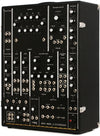Moog Model 10 Modular Synthesizer.
Reissue Modular Synthesizer with 11 Discrete, Handcrafted Modules.
The Moog Model 10 is a meticulous re-creation of the first compact modular synthesizer system created by Dr. Robert Moog in 1971. Engineered for portability, the Model 10 is housed in a road-ready Tolex-clad wood cabinet hand-assembled with 11 discrete analog modules, including three 900-Series oscillators, venerated for their magical sonic depth; and a 907 Fixed Filter Bank, acclaimed for its massive sound-shaping and timbral potential. The predecessor of the Model 15, the Model 10 design is focused on purity of sound and ease of use, while delivering the immense sonic depth and dimensionality you expect only from vintage Moog modular synthesizers. Used Moog modulars in operating condition command a pretty penny — if you can find one. The Moog Model 10 reissue is your opportunity to own the genuine article, complete with modern reliability and a warranty. It’s a no-brainer.
The Synthesizer Model 10 reissue is handcrafted from original 1971 factory specifications, using the same assembly methods in use at the Moog factory in 1971. Each system features 11 hand-stuffed, hand-soldered modules, including three 901-Series voltage-controlled audio Oscillators, two 911 Envelope Generators, the 902 voltage-controlled Amplifier, and of course the legendary 904A voltage-controlled lowpass Ladder Filter. All modules are tested, finished with an aluminum panel, and securely mounted in a rugged, Tolex-covered road case at Moog's Asheville, NC factory. It’s worth noting that the Moog System 55, System 35, and Model 15 reissues do not use the 901 oscillator; the Model 10 (along with and Modular IIIP) is your only way to access this historic sound.Many synth lovers feel the Moog 901 is the best-sounding oscillator ever built. Back in the late ’60s, electric components weren't as accurate as they are today. Early oscillators demonstrated thermal instability and would infamously drift after heating up onstage or in the studio. As synthesizers became ubiquitous in professional settings, tuning stability became more important, so in 1972 Moog replaced the 901 oscillator with the 921. The new model featured improved temperature stability, tracking accuracy, and additional functionality such as the ability to synchronize with voltage-controlled pulse width. But the waveform imperfections and slow drift that “plagued” the earlier designs also added a raw, organic, “human” character to the sound.
-
1 x 901 Voltage Controlled Oscillator
-
1 x 901A Oscillator driver
-
2 x 901B Oscillators
-
1 x 902 Voltage Controlled Amplifier
-
1 x 903A Random Signal Generator
-
1 x 904A Voltage Controlled Low Pass Filter
-
1 x 907 Fixed Filter Bank
-
2 x 911 Envelope Generators
-
1 x CP11 Console Panel
-
1 x 130 Watt 120 VAC Power Supply
-
10 x 1-foot 1/4-inch TS cables
-
8 x 2-foot 1/4-inch TS cables
-
2 x 1-foot S-Trigger cables
-
1 x 1.5-foot S-Trigger cable
-
1 x Y-cable S-Trigger
-
Included power cable and hardcover Owner’s Manual




